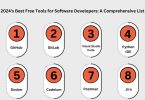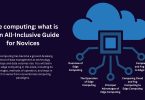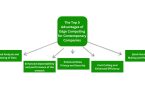Because edge computing alters the way data is handled, stored, and used, it has the potential to totally change a number of sectors. It becomes increasingly important to comprehend edge computing’s trend as we advance farther into the digital world. This article sheds light on edge computing’s noteworthy influence and future potential by examining the major trends and projections for the technology through 2025 and beyond.
Edge Computing: Direct Access to Processing Power
By bringing processing power closer to the point of data generation, edge computing offers a novel approach to data management. Edge computing moves processing and data storage to the edge of the network rather than depending only on centralized data centers. This tactical change significantly cuts down on the amount of time needed to analyze information, allowing for quicker decision-making and prompt replies. Edge computing minimizes latency and maximizes network bandwidth by reducing the distance that data must travel, making it a crucial technology for applications that require instantaneous insights.
Reasons for Adoption of Edge Computing
The following are some of the causes driving edge computing’s adoption:
- Data Explosion: As the number of IoT devices rises, enormous volumes of data are produced that need to be processed effectively.
- Low Latency Requirements: Applications like driverless cars and industrial automation require real-time data processing.
- Bandwidth Optimization: Local data processing reduces network bandwidth strain, leading to cost savings.
- Enhanced Security and Privacy: Localizing data minimizes transmission risks and enhances data security.
Key Trends in Edge Computing
1. Billions of Edge Devices will Lead to an Explosion in New Data Processing
Prediction: More than half the data created and processed by enterprises will exist outside their traditional centralized data centers or clouds by 2025. This trend reflects the growing need for faster, more efficient data processing at or near its generation point. The requirement for real-time analytics and the exponential growth of IoT devices are driving this trend. In order to handle and process this data efficiently and guarantee a smooth interaction with cloud systems, businesses need to implement complete edge solutions.
2. Evolving Connectivity Solutions
Prediction: Over 80% of edge devices using 5G as their primary connectivity will be dismantled or decommissioned from 2022-24 due to bandwidth cost concerns. Although 5G was portrayed as a breakthrough for edge computing, prohibitive data usage prices have forced some to reassess their position. Now, organizations are looking for more affordable asynchronous alternatives to blade the expense of bandwidth and they underscore that successful operations have been optimized with smart software (automation) amplifying cost efficiencies.
3. Including Machine Learning at the Periphery
Prediction: By 2027, more than 65% of edge use cases will include machine learning (ML), rising from less than 10% in 2021. ML and deep learning (DL) at the edge will drive forward improvements in data processing capabilities, which allows further development of real-time analytics and decision-making. This trend will require greater power and storage requirements which in turn will drive the need for increasing large-scale infrastructure solutions.
4. Enhanced Security Measures
Forecast: By 2025, as enterprises merge OT (operational technology) and IT, security breaches on the edge network will reach one in four nodes, more than a hundredfold increase over measured breach rates of less than a quarter percent in 2021. As edge deployments grow, so do security risks. Strong cybersecurity measures, such as network and physical security, must be put in place. To safeguard your data and infrastructure, you must implement a full suite of access controls, encryption, and monitoring technologies.
5. Autonomous Commands and Redundancy Deployments
Expected in the Future: As edge computing evolves, autonomous operation will buy sede of higher functionality driven by AI/MLiom predicated upon five functions. More resilient and efficient operations will be enabled by the reduced need for human intervention in autonomous edge systems. This incorporates everything from predictive maintenance to automated troubleshooting and self-healing networks that will both increase uptime and improve performance.
Industry Applications and Use Cases
Healthcare
Real-time analysis of health data through wearable devices and medical equipment is transforming healthcare with the help of edge computing. It allows for better, real-time monitoring of the patient in general and adds valuable diagnostic insights – all contributing to improved healthcare outcomes.
Manufacturing
Edge computing makes it possible to monitor and operate machinery and processes in real-time in the industrial sector, which boosts productivity, lowers downtime, and improves predictive maintenance capabilities.
Retail
Retailers are using edge computing to improve consumer experiences by providing personalized marketing, better inventory management, and up-to-the-moment analytics on consumer behaviors.
Smart Cities
Smart cities use edge computing extensively to analyze data collected by numerous sensors and devices. Edge computing: Along with reducing delays, edge computing can help to manage traffic more efficiently and optimize energy use by public safety systems.
Autonomous Vehicles
Edge computing is essential for the autonomous vehicles to be built and deployed. FusionEngine6/9 produces in-line and on-time sensor data processing for navigation, collision detection/aversion as well as safety.
Forecasts for 2025 and Beyond:
Higher Adoption in All Sectors
By 2025, organizations are expected to have made greater use of edge computing across a wider range of industries. Edge computing will also make its presence felt more extensively in manufacturing, where it is used for real-time quality control and predictive maintenance. Healthcare also use this for patient monitoring and data analysis which leads to improving the outcome of patients thus saves cost in healthcare.
Enhanced Security and Compliance
Data sovereignty concerns are growing every day, as a result of which edge computing will become an enabler for ensuring data compliance. By processing data at the edge, workloads can require adherence to privacy regulations based on geography (like GDPR) and an extra layer of security.
Cooperation as well as compatibility
This will facilitate much-needed cooperation in the market for edge computing. Collaborations between multivendor partners will enhance product integration and engagement, enhancing edge connectivity and services.
Challenges and Considerations
There are several challenges which edge computing has to address for it to fully realize its potential:
Data Management: It is challenging in dealing with large volumes of data as they come from the edges.
Security & Privacy: Proper measures have to set up, so that no unauthorized access or threats reach till an edge. Management at one place is a very cumbersome task.
Conclusion
Edge computing has the potential to change a wide range of sectors by providing real-time data processing, low latency, and great bandwidth efficiency. Advances in 5G networks and edge infrastructure between now and through at least 2025, as well as more effective collaboration among stakeholders, will pave the eventual adoption of universal changes to computing on edge. Edge computing will make efficiency, security, and immediate data processing not just a thing of yesterday or today but also shape the way we work in the Technology era.








